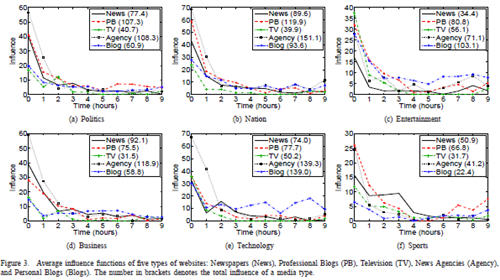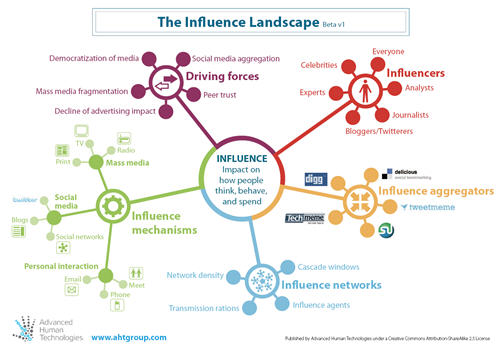It is the structure of social networks that shapes influence… and the structure is changing
New York Times today examines the interesting question of Why Some Twitter Posts Catch On, and Some Don’t, starting from the fact that frivolous hashtags such as #worstpickuplines get far more attention than commentary on current affairs such as ‘Mubarak’, and going on to look at a range of research on influence.
The article quotes research which implies what I and a handful of others have been saying for quite a years now.
The structure of a social network — for example, whether it is made up of close friends and colleagues or of like-minded strangers who follow Lady Gaga — can have more influence than the size of a group, researchers say.
My Influence Landscape from 2009 shows the key elements of influence, including a section on ‘Influence Networks’ showing the elements of social network structure that drive the dissemination of influence.
As I commented in a 2007 post about other research on online influence,
What interests me in particular is how the structure of these influence networks will evolve – we are absolutely in a transition phase, and the way social opinion is formed will quickly change.
It is one thing to understand and dig into the structure of influence networks being far more important than individual influencers (see this commentary on Duncan Watts and the debate on whether “influentials” really matter).
Beyond that point the key topic becomes how this structure is changing.
A recent great study by Yang and Leskowec at Stanford University titled Modeling Information Diffusion in Implicit Networks provides an underlying model and brings up some interesting findings

Source: Modeling Information Diffusion in Implicit Networks
Findings include that professional blogs are the most influential news media in sports and the second most influential media in politics and national news, while personal blogs are the most influential in entertainment and the second most influential in technology. In general the influence of blogs tends to decay more slowly than other media.
One of the most intersting conclusions is that the most visible agents may not be the most influential when it comes to “social ” phenomena such as hashtags.
“As the adoption of short, news-related textual phrases appears active users, each of which has relatively less influence. Moreover, we also observe that users with the most followers are not the most influential in propagating hashtags.”
There is far more for us to discover about the details of how the structure of social networks drives influence, not least because those structures are rapidly changing.

